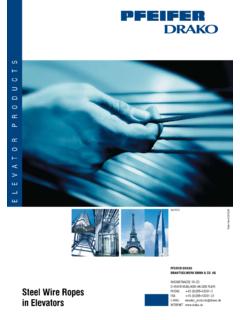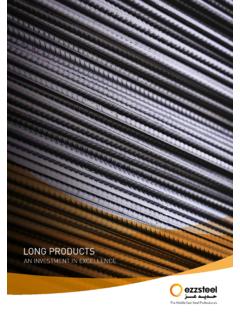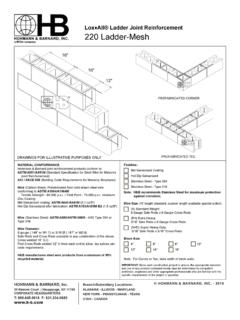Transcription of UDC 669 . 184 . 244 . 66 : 669 . 14 - 422 Technical ...
1 NIPPON steel Technical REPORT No. 104 AUGUST 2013-117-1. IntroductionFounded in 1909, Nippon steel Corporation s Muroran Works (hereinafter simply called Muroran ) is the only integrated iron and steel works in Hokkaido and manufactures special steels for bars and wire rods. Nearly 90% of the products of Muroran are special steels, which are used mainly for critical automotive components (the engine, driving system, and undercarriage) and various parts of industrial machinery and construction equipment (Fig. 1). Since 1994, Muroran has also been manufacturing bars and wire rods in cooperation with Mitsubishi steel Muroran, Inc. (hereinafter called MSR ) and secondary processors/users (Fig. 2). In this report, we describe the progress in steelmaking technology for manufacturing special steel bars and wire rods at Outline of Muroran WorksIn 1994, the ironmaking department of Muroran was separated from Nippon steel Muroran Works, and the former was used to es-tablish 80% of a joint venture with MSR, known as Hokkai Iron & Coke Corporation.
2 Since then, Hokkai Iron & Coke has been the supplier of hot metal to Muroran s basic oxygen furnace (converter) and electric furnace. The steel source used at Muroran is converter Technology UDC 669 . 184 . 244 . 66 : 669 . 14 - 422* Department Manager, Steelmaking Technical Dept., Steelmaking Div., Muroran Works 12 Nakamachi, Muroran, Hokkaido 050-8550 Technical Progress in Steelmaking and Casting for Special Bar and Wire steel at Muroran WorksMasato KOBAYASHI* Kohichi ISOBEM asayuki ARAIA bstractMuroran Works, Nippon steel Corporation manufactures special bars and wire rods mainly for automotive parts. In steelmaking plant, many technologies have been developed to manufacture high grade special steel and to suit the users various needs, multi-refin-ing converter (MURC), secondary steelmaking and casting to improve steel cleanliness, and near net casting and compact high reduction process (NCR).
3 Authors describe recent ad-vances and prospects in steelmaking and casting technologies for manufacturing special steel in Muroran 1 Product mix of Muroran Works ( )Fig. 2 Process routes of Muroran WorksNIPPON steel Technical REPORT No. 104 AUGUST 2013-118- steel (with a heat size of 270 t/ch), which is passed through the ladle furnace (LF) and vacuum degassing equipment (RH) and is cast on the No. 3 continuous caster (3CC). The crude steel production ca-pacity of Muroran is about 1,500,000 tons a year. The 3CC is a curved-type continuous caster having a machine radius of 12 m. It is capable of casting medium-section bloom (BL) (220 mm square) and large-section BL (350 mm 560 mm). The medium-section BL has advantages in terms of isotropy and cost because it is obtained by the near-net-shape casting process, whereas the large-section BL is advantageous in terms of the removal of nonmetallic inclusions (hereinafter simply called inclusions ) in the mold because it is ob-tained by the large cross-section bloom casting process.
4 Either cast-ing process is selected according to the steel grade with consider-ation given to the above BL and large-section BL are rolled on separate lines. The former is rolled in a 4-pass continuous horizontal-vertical (HV) rolling line called NCR (near net casting and compact high re-duction) line, and the latter is rolled in a medium and large-section rolling (reversing rolling + continuous HV rolling) line. In either case, the bloom is rolled into a 162 mm square billet (BT). After in-spection and conditioning, the BT is rolled into bars (19 mm to 120 mm across) and bars-in-coil (BIC) (19 mm to 60 mm across) at the bar mill or into wire rods ( mm to 22 mm across) at the wire rod mill according to the product the other hand, the steel source used at MSR (with a heat size of 110 t/ch) consists of converter steel transported from Muro-ran and electric furnace steel made from scrap and hot metal (with a mixing ratio of 30% to 50%).
5 After being subjected to the LF/RH treatment, the steel is cast on a continuous caster. The crude steel production capacity of MSR is about 700,000 tons a year. The con-tinuous caster is a curved type having a machine radius of 16 m. It casts large-section BLs (370 mm 515 mm), which are mostly rolled into large-diameter bars by the medium- to large-section roll-ing line of Progress of steel Refining Development of multi-refining converter (MURC) processFor primary refining, desiliconization and dephosphorization of hot metal use of a torpedo car (TPC) had been applied in the past. However, since the pretreatment of hot metal using a TPC was inef-ficient, owing to the small reactive interface, the pretreatment time was so much longer than the cycle time of converter that difficult preparatory work was required to synchronize this condition, and in conjunction with the surplus pro-duction capacity of its converter, Muroran developed a new process called the Multi-Refining Converter (MURC) process whereby the surplus production capacity of the converter was utilized to deslag and decarbonize the hot metal after desiliconization and dephospho-rization 1-3) (Fig.
6 3). This new process has made it possible to attain a turndown phosphorus content, after decarbonization, of P , within 70 minutes of steelmaking cycle time on a consistent basis. In addition, since the process has significantly increased the thermal capacity and eliminated the need for tapping after dephosphoriza-tion, it has become possible to use large quantities of scrap in the hot metal pretreatment process. In the MURC process, the hot metal dephosphorization and decarbonization are performed in the same converter. Therefore, the deslagging ratio during intermediate deslagging determines the attainable turndown phosphorus content (Fig. 4). This means that it is important to form an easy-to-remove slag during desiliconization and dephosphorization of the hot metal.
7 In order to improve the deslagging ratio without causing the hot metal to flow out of the converter, it is necessary to control the slag composition and foaming condition by the top-blowing lance and thereby secure a slagging ratio of 70% or more on a consistent Development of the F-MURC processHowever, the inadequacy of the dephosphorization process be-came conspicuous in light of the increasingly stringent regulations on inclusions demanded by special steels, which required a reduc-tion of the phosphorus content and the setting of a low limit to the end-point carbon content. Therefore, the TPC pretreatment of hot metal could not be completely replaced with the MURC process. Under that condition, Muroran developed a new process called the Flexible MURC (F-MURC) process that applies, as required, the tapping & slagging process that minimizes the influence of rephos-phorization by the residual slag (Fig.)
8 5).1, 4) With the MURC process, the intermediate deslagging ratio was about 70%. As a benefit, the F-MURC process has made it possible to almost completely sepa-rate the slag from the dephosphorized molten metal and reduce the phosphorus content of the hot metal charged for decarbonization by Fig. 3 MURC processFig. 4 Relationship between deslagging ratio and P at blow end 1)Fig. 5 F-MURC processNIPPON steel Technical REPORT No. 104 AUGUST 2013-119-tapping the whole of the hot metal subjected to desiliconization and dephosphorization, removing the slag from the converter complete-ly, and then recharging the dephosphorized hot metal into the to the F-MURC process, the dephosphorization process capacity increased dramatically, allowing for a turndown phospho-rus content after decarbonization of P , even with an end-point carbon content greater than As a result, it became pos-sible to omit the TPC pretreatment of hot metal.
9 The F-MURC process comprises three patterns of processing: the MURC process, the tapping and deslagging process using a single converter, and the tapping and deslagging process using two exclusive converters. The MURC process that uses the same furnace is the most advantageous in terms of thermal capacity and is capable of melting scrap most efficiently. On the other hand, the process using two exclusive con-verters is the most advantageous in terms of the dephosphorization process capacity, but it is not capable of melting scrap very effi-ciently and hence it does not permit increasing the scrap mixing ra-tio significantly. Thus, the salient feature of the F-MURC process is that it permits selecting the optimum processing pattern according to production level, steel grade, and furnace repair Maximizing the effect of the F-MURC process by applying all LF treatmentThe quality requirements of special steel bars and wire rods have become increasingly stringent.
10 Especially prominent is the ever-in-creasing demand for exceptionally clean special steels and high-al-loy special steels reflecting the increase in proportion of case-hard-ening steel , tough and hard steel , and non-tempered steel . Under these conditions, with the aim of further enhancing the cleanness of molten steel , improving the thermal distribution in the refining processes, and streamlining the material flow, Muroran installed an additional LF and started implementing secondary refining of the entire molten steel using a pair of LFs in 2008 (Fig. 6).5)From the standpoint of increasing the capacity of the dephos-phorization process using a converter, it is effective to lower the end-point temperature (Fig. 7). As a result of a redistribution of the secondary refining thermal load between BOF and LF and the im-plementation of the BOF operation at a low end-point temperature, made possible by the installation of the additional LF (Fig.















